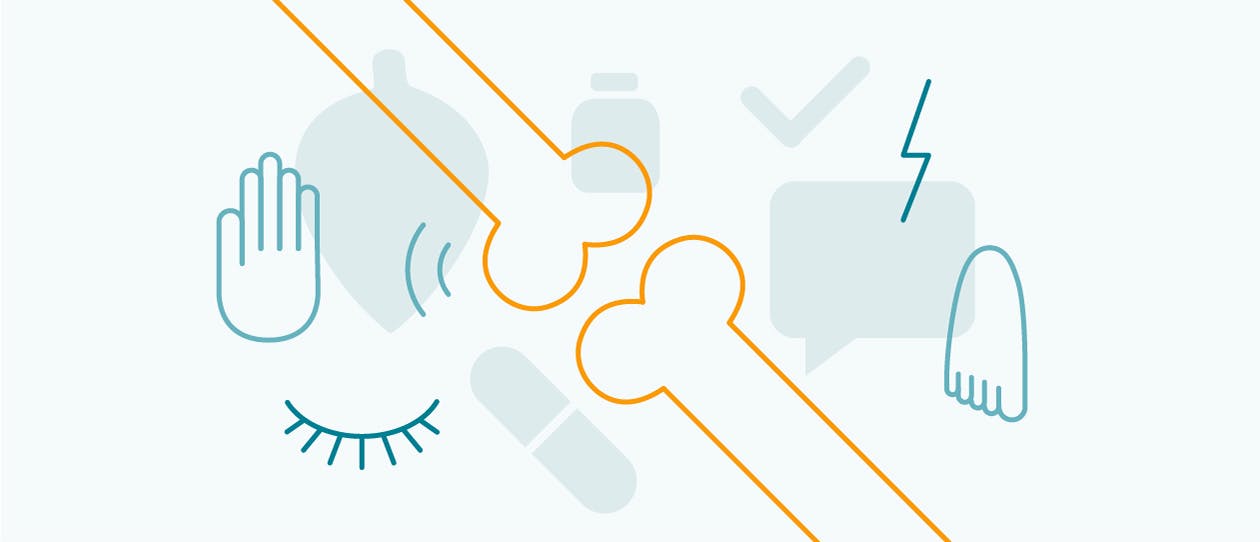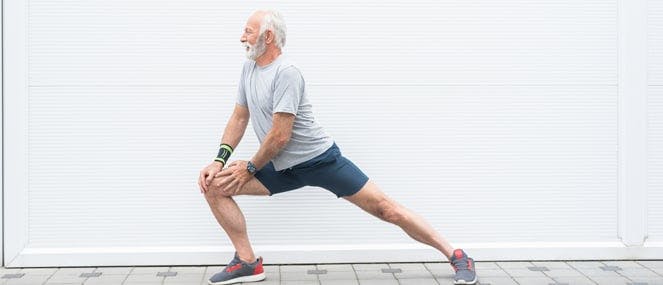
- Health hub/
- Arthritis, joint, bone & muscle/
- Osteoporosis: Symptoms, Causes and Treatments


People with osteoporosis typically have no symptoms in the early stages of the condition, and for many sufferers, a fracture is the first sign of the disease. Fractures may occur from even a slight trauma to the bones, which become thinner and weaker as the disease progresses. With every fracture that occurs, the likelihood that another will be experienced is increased.
Fractures most commonly affect the spine, pelvis, hips, ribs, and arms, and may have a significant impact on mobility and independence.
Symptoms due to fractures may include:
- Back pain
- A gradual loss of height often with a stooped back (Dowager’s hump)
- Muscle weakness
About 99% of the body’s calcium is stored in the skeleton. The remaining 1% is present in the blood and other body fluids, where it is critical to the maintenance of a wide range of body functions.
To ensure there is sufficient calcium available to maintain vital body functions, calcium moves out of the bones and into the blood as required.
Osteoporosis occurs when the bones lose calcium more quickly than it can be replaced, and over time this leads to a decline in the density and mass of the bones, makes them more susceptible to fracture.
Most of our bone mass is laid down during childhood before puberty, and we reach our peak bone mass at about 30 years of age. After that point, the bones become thinner and weaker. In women, this process accelerates after menopause, due to declining oestrogen levels.
To prevent osteoporosis, it is essential that you get adequate calcium and vitamin D over the course of your life, including in childhood.
Some health conditions increase your risk of developing osteoporosis. These include diseases affecting the thyroid and parathyroid glands, rheumatoid arthritis, coeliac disease (and other chronic bowel conditions), chronic liver and kidney disease, and eating disorders . Some medicines also increase the risk of osteoporosis; corticosteroids (commonly used to treat asthma and rheumatoid arthritis) are one example, but there are also many others. Talk to your doctor about the specific medicines you take.
Other risk factors for osteoporosis include:
- Being female
- Getting older
- Being Caucasian, Asian or Latino
- Having a slight or slender frame; being underweight
- Having a family history of osteoporosis or fractures
- Having a personal history of broken bones during adulthood
- Experiencing an early menopause
- Being inactive for an extended period at some stage of life
- Excessive alcohol consumption
- Smoking (which is associated with increased risk of fracture and delayed healing )
- For women, experiencing times of infrequent or absent periods at some stage in life (other than due to pregnancy, menopause or hysterectomy)
- For men, having low testosterone levels (which may be suggested by low libido and erectile dysfunction)
- Calcium intake is especially important for post-menopausal women, who have greater calcium requirements than other people. Taking calcium supplements may be of assistance in the prevention and treatment of osteoporosis. Look for a product containing a combination of calcium compounds - calcium phosphate, calcium citrate and calcium amino acid chelate. Vitamin D3 as well as magnesium, phosphate and other minerals should also be present to aid the absorption and function of calcium.
- Vitamin D3 promotes the absorption of calcium and phosphate (from the small intestine) and makes them available for use by the skeleton. Having low levels of vitamin D is an established risk factor for falls, and increased falls may increase the risk of fractures. In older people, taking vitamin D3 leads to improved muscle strength, and this helps reduce the incidence of falls.
- We get most of our vitamin D3 from the action of sunlight on the skin, but many people don’t obtain enough vitamin D this way, contributing to an increased risk of osteoporosis. People whose skin has limited exposure to sunlight are at particular risk of vitamin D deficiency, in particular, older people, those who are housebound, and women who wear traditional dress that covers most of the body.
- Magnesium is essential for healthy bones and muscles.
- Dairy foods are the most important source of calcium in most people’s diets. Unless you’re allergic to milk or lactose, try to include several serves of low fat dairy foods in your diet every day.
- Other important sources of calcium include tinned salmon and sardines (eat the soft bones, which are rich in calcium), soy milk that has been fortified with extra calcium, broccoli, beans and almonds.
- At the same time, avoid consuming large quantities of animal proteins (e.g. red meat) as they increase calcium excretion. Excessive amounts of alcohol, caffeine and soft drink should also be avoided for this reason.
- Avoid foods high in oxalic acid, which include beetroot and beet leaves, spinach and silver beet, celery, eggplant, green beans, green capsicum, figs, kiwifruit, rhubarb, wheat products (including whole grain varieties), oatmeal, chickpeas, lentils, soy products, nuts, seeds, beer, chocolate and tea as they decrease calcium absorption. Phytates (found in cereals and bran) have similar effects.
- Stick to a low salt diet, because sodium decreases your body’s ability to retain calcium.
- Make sure you expose around 15% of your body to the sun (for example your hands, face and arms) 4-6 times per week for 6-8 minutes. Older people should expose themselves to sunlight more frequently (5-6 times a week), and people with dark skin should expose themselves for a longer period of around 15 minutes. Early morning or late afternoon sunlight is best; avoid sun exposure during the heat of the day, when sun-related skin damage is most likely to occur.
- Regular exercise is important for bone density, muscle strength, coordination and balance. However if your bones and joints are weak, some forms of exercise may be inappropriate for you - ask your healthcare professional or physiotherapist for advice. Weight bearing exercise (e.g. jogging or walking) and strength training (e.g. resistance exercise such as weight lifting) are the most important types of exercise for the prevention of osteoporosis, and ideally your exercise regime should incorporate both forms of activity.
- Stop smoking.
If you have osteoporosis or are at high risk of developing it, your doctor may recommend you undergo bone density testing (DXA), and in addition to lifestyle changes like those discussed above, may prescribe medication to delay bone loss and reduce the risk of fracture.




